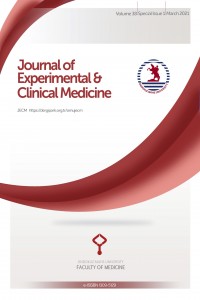Abstract
Supporting Institution
yok
Thanks
Doç Dr. Talat Ayyıldız
References
- Abdulsamad, M., Reddy, P., Guvvala, S., Dev, A., 2017. Recombinant Factor VIIa Use for Endoscopic Retrograde Cholangiopancreatography with Sphincterotomy in a Patient with Choledocholithiasis and Unusual Coagulopathy. Gastroenterology Res. 10, 144–146.
Abstract
Clinically significant bleeding is an uncommon complication of diagnostic endoscopic retrograde cholangiopancreatography. But the endoscopists needs to be skilled at prevention and management. Post ERCP bleeding is most often seen following sphincterotomy. The overall risk of bleeding in patients undergoing sphincterotomy is approximately 1-2 percent. Most bleeding episodes are mild to moderate in severity. The risk of bleeding can be minimized by identifying patients at risk, correcting coagulation abnormalities and careful technique by skilled endoscopists in high-volume centers. Post-sphincterotomy bleeding often stops spontaneously and is rarely life-threatening, except in patients with a bleeding diathesis. Most clinically relevant bleedings can be managed with medical treatment and/or endoscopic therapy, which should be performed without delay in patients who have immediate bleeding. Endoscopic therapy options include epinephrine
injection, hemostatic clips, thermal therapy and placement of full covered self-expandable metal stents. Angiography or surgery is usually reserved for patients with refractory bleeding and is rarely required.
References
- Abdulsamad, M., Reddy, P., Guvvala, S., Dev, A., 2017. Recombinant Factor VIIa Use for Endoscopic Retrograde Cholangiopancreatography with Sphincterotomy in a Patient with Choledocholithiasis and Unusual Coagulopathy. Gastroenterology Res. 10, 144–146.
Details
| Primary Language | English |
|---|---|
| Subjects | Health Care Administration |
| Journal Section | Clinical Research |
| Authors | |
| Publication Date | March 18, 2021 |
| Submission Date | July 20, 2020 |
| Acceptance Date | November 10, 2020 |
| Published in Issue | Year 2021 Volume: 38 Issue: 2s |
Cite

This work is licensed under a Creative Commons Attribution-NonCommercial 4.0 International License.


